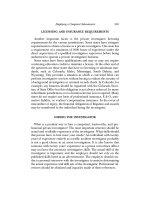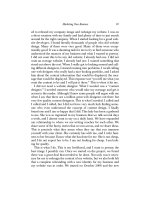A Guide to MATLAB for Beginners and Experienced Users phần 9 docx
Bạn đang xem bản rút gọn của tài liệu. Xem và tải ngay bản đầy đủ của tài liệu tại đây (371.98 KB, 32 trang )
Solutions to Practice Set B: Calculus, Graphics, and Linear Algebra
241
pretty(ans)
(n + 1)
r1
-
r-1 r-1
(c)
symsum(xˆk/factorial(k), k, 0, Inf)
Error using ==> factorial
N must be a matrix of non-negative integers.
Here are two ways around this difficulty.
symsum(xˆk/gamma(k + 1), k, 0, Inf)
ans =
exp(x)
symsum(xˆk/sym(’k!’), k, 0, Inf)
ans =
exp(x)
(d)
symsum(1/(z - k)ˆ2, k, -Inf, Inf)
ans =
piˆ2+piˆ2*cot(pi*z)ˆ2
242
Solutions to the Practice Sets
7.
(a)
taylor(exp(x), 7, 0)
ans =
1+x+1/2*xˆ2+1/6*xˆ3+1/24*xˆ4+1/120*xˆ5+1/720*xˆ6
(b)
taylor(sin(x), 5, 0)
ans =
x-1/6*xˆ3
taylor(sin(x), 6, 0)
ans =
x-1/6*xˆ3+1/120*xˆ5
(c)
pretty(taylor(sin(x), 6, 2))
23
sin(2) + cos(2) (x - 2) - 1/2 sin(2) (x - 2) - 1/6 cos(2) (x - 2)
45
+ 1/24 sin(2) (x - 2) + 1/120 cos(2) (x - 2)
(d)
taylor(tan(x), 7, 0)
ans =
x+1/3*xˆ3+2/15*xˆ5
Solutions to Practice Set B: Calculus, Graphics, and Linear Algebra
243
(e)
taylor(log(x), 5, 1)
ans =
x-1-1/2*(x-1)ˆ2+1/3*(x-1)ˆ3-1/4*(x-1)ˆ4
(f)
pretty(taylor(erf(x), 9, 0))
35 7
xx x x
2 - 2/3 + 1/5 - 1/21
1/2 1/2 1/2 1/2
pi pi pi pi
8.
(a)
syms x y; ezsurf(sin(x)*sin(y), [-3*pi 3*pi -3*pi 3*pi])
−5
0
5
−5
0
5
−1
−0.5
0
0.5
1
x
sin(x) sin(y)
y
(b)
syms x y; ezsurf((xˆ2 + yˆ2)*cos(xˆ2 + yˆ2), [-1 1 -1 1])
244
Solutions to the Practice Sets
−1
−0.5
0
0.5
1
−1
0
1
−1
−0.5
0
0.5
1
x
(x
2
+y
2
) cos(x
2
+y
2
)
y
9.
T = 0:0.01:1;
for j = 0:16
fill(4*cos(j*pi/8)+(1/2)*cos(2*pi*T),
4*sin(j*pi/8)+(1/2)*sin(2*pi*T), ’r’);
axis equal; axis([-5 5 -5 5]);
M(j+1) = getframe;
end
movie(M)
−5 0 5
−5
0
5
Obviously we can’t show the movie in this book, but you see the last frame above.
Solutions to Practice Set B: Calculus, Graphics, and Linear Algebra
245
10.
(a)
A1=[345;2-37;1-61];b=[2;-1;3];
format short; x = A1\b
x=
2.6196
-0.2283
-0.9891
A1*x
ans =
2.0000
-1.0000
3.0000
(b)
A2 = [3 -9 8; 2 -3 7; 1 -6 1]; b = [2; -1; 3];
x = A2\b
Warning: Matrix is close to singular or badly scaled.
Results may be inaccurate. RCOND = 4.189521e-18.
x=
-6.0000
-1.3333
1.0000
A2*x
ans =
2
-1
3
The matrix A2 is singular. In fact,
det(A2)
ans =
0
246
Solutions to the Practice Sets
(c)
A3 = [1 3 -2 4; -2 3 4 -1; -4 -3 1 2; 2 3 -4 1];
b3 = [1; 1; 1; 1]; x = A3\b3
x=
-0.5714
0.3333
-0.2857
0
A3*x
ans =
1.0000
1.0000
1.0000
1.0000
(d)
syms a b c d x y u v;
A4 = [a b; c d]; A4\[u; v]
ans =
(d*u-b*v)/(d*a-b*c)
-(c*u-v*a)/(d*a-b*c)
det(A4)
ans =
d*a-b*c
The determinant of the coefficient matrix is the denominator in the answer. So one
gets an answer only if the coefficient matrix is non-singular.
Solutions to Practice Set B: Calculus, Graphics, and Linear Algebra
247
11.
(a)
rank(A1)
ans =
3
rank(A2)
ans =
2
rank(A3)
ans =
4
rank(A4)
ans =
2
MATLAB implicitly assumes that ad − bc is not 0 here.
(b)
Only the second one computed is singular.
248
Solutions to the Practice Sets
(c)
det(A1)
ans =
92
inv(A1)
ans =
0.4239 -0.3696 0.4674
0.0543 -0.0217 -0.1196
-0.0978 0.2391 -0.1848
det(A2)
ans =
0
The matrix A2 does not have an inverse.
det(A3)
ans =
294
inv(A3)
ans =
0.1837 -0.1531 -0.2857 -0.3163
0 0.1667 0 0.1667
0.1633 0.0306 -0.1429 -0.3367
0.2857 -0.0714 0 -0.2143
det(A4)
Solutions to Practice Set B: Calculus, Graphics, and Linear Algebra
249
ans =
d*a-b*c
inv(A4)
ans =
[ d/(d*a-b*c), -b/(d*a-b*c)]
[ -c/(d*a-b*c), a/(d*a-b*c)]
12.
(a)
[U1, R1] = eig(A1)
U1 =
-0.9749 0.6036 0.6036
-0.2003 0.0624 + 0.5401i 0.0624 - 0.5401i
0.0977 -0.5522 + 0.1877i -0.5522 - 0.1877i
R1 =
3.3206 0 0
0 -1.1603 + 5.1342i 0
0 0 -1.1603 - 5.1342i
A1*U1 - U1*R1
ans =
1.0e-14 *
0.3109 0.2776 - 0.3997i 0.2776 + 0.3997i
-0.0444 0 - 0.0777i 0 + 0.0777i
-0.0833 0.0999 - 0.1776i 0.0999 + 0.1776i
This is essentially zero. Notice the e-14.
[U2, R2] = eig(A2)
250
Solutions to the Practice Sets
U2 =
0.9669 0.7405 0.7405
0.1240 0.4574 - 0.2848i 0.4574 + 0.2848i
-0.2231 0.2831 + 0.2848i 0.2831 - 0.2848i
R2 =
-0.0000 0 0
0 0.5000 + 6.5383i 0
0 0 0.5000 - 6.5383i
A2*U2 - U2*R2
ans =
1.0e-14 *
-0.2224 -0.2554 - 0.2665i -0.2554 + 0.2665i
-0.1498 0.0888 0.0888
-0.1156 -0.0222 + 0.0666i -0.0222 - 0.0666i
Same comment as in (a).
[U3, R3] = eig(A3);
max(abs(A3*U3 - U3*R3))
ans =
1.0e-14 *
0.4529 0.4529 0.5245 0.5245
Ditto yet again. (Note that we suppressed the output of the first command, and
took the maximum of the absolute values of the entries in each column of A3*U3
- U3*R3, in order to keep the data from scrolling off the screen.)
[U4, R4] = eig(A4);
pretty(U4)
[ 2 2 1/2
[ 1/2d-1/2a-1/2(d -2da+a +4bc)
[- ,
[c
Solutions to Practice Set B: Calculus, Graphics, and Linear Algebra
251
2 2 1/2]
1/2d-1/2a+1/2(d -2da+a +4bc) ]
- ]
c]
[1 , 1]
pretty(R4)
[221/2]
[1/2d+1/2a+1/2(d -2da+a +4bc) ,0]
[]
[ 2 2 1/2]
[0,1/2d+1/2a-1/2(d -2da+a +4bc) ]
simplify(A4*U4 - U4*R4)
ans =
[0,0]
[0,0]
(b)
A=[102;-104;-1-15];
[U1, R1] = eig(A)
U1 =
-0.8165 0.5774 0.7071
-0.4082 0.5774 -0.7071
-0.4082 0.5774 0.0000
R1 =
2.0000 0 0
0 3.0000 0
0 0 1.0000
B = [5 2 -8; 3 6 -10; 3 3 -7];
[U2, R2] = eig(B)
252
Solutions to the Practice Sets
U2 =
0.8165 -0.5774 0.7071
0.4082 -0.5774 -0.7071
0.4082 -0.5774 0.0000
R2 =
2.0000 0 0
0 -1.0000 0
0 0 3.0000
We observe that the first and second columns of U1 are negatives of the corresponding
columns of U2, and the third columns are identical. Finally,
A*B - B*A
ans =
000
000
000
13.
(a)
If we set X
n
to be the column matrix with entries x
n
, y
n
,andz
n
,andM the square
matrix with entries 1, 1/4, 0; 0, 1/2, 0; 0, 1/4, 1 then X
n+1
= MX
n
.
(b)
We have X
n
= MX
n−1
= M
2
X
n−2
= = M
n
X
0
.
(c)
M = [1, 1/4, 0; 0, 1/2, 0; 0, 1/4, 1];
[U,R] = eig(M)
U=
1.0000 0 -0.4082
0 0 0.8165
0 1.0000 -0.4082
Solutions to Practice Set B: Calculus, Graphics, and Linear Algebra
253
R=
1.0000 0 0
0 1.0000 0
0 0 0.5000
(d)
M should be URU
−1
. Let’s check:
M - U*R*inv(U)
ans =
000
000
000
Since R
n
is the diagonal matrix with entries 1, 1, 1/2
n
, we know that R
∞
is the
diagonal matrix with entries 1, 1, 0. Therefore M
∞
= UR
∞
U
−1
.So
Minf = U*diag([1, 1, 0])*inv(U)
Minf =
1.0000 0.5000 0
000
0 0.5000 1.0000
(e)
syms x0 y0 z0; X0 = [x0; y0; z0]; Minf*X0
ans =
x0+1/2*y0
0
1/2*y0+z0
Half of the mixed genotype migrates to the dominant genotype and the other half of
the mixed genotype migrates to the recessive genotype. These are added to the two
original pure types, whose proportions are preserved.
254
Solutions to the Practice Sets
(f)
Mˆ5*X0
ans =
x0+31/64*y0
1/32*y0
31/64*y0+z0
Mˆ10*X0
ans =
x0+1023/2048*y0
1/1024*y0
1023/2048*y0+z0
(g)
With the suggested alternate model, only the first three columns of the table are rel-
evant, the transition matrix M becomes M = [1 1/2 0; 0 1/2 1; 0 0 0].
You can compute that the eventual population distribution is [1 0 0], and is inde-
pendent of the initial population.
14.
The following commands create a JPEG file of the French flag. The set command
has no effect on the JPEG file; we include it only to turn off the axis ticks in the figure
window.
A = zeros(200, 300, 3);
A(:, 1:100, 3) = ones(200, 100);
A(:, 101:200, 1) = ones(200, 100);
A(:, 101:200, 2) = ones(200, 100);
A(:, 101:200, 3) = ones(200, 100);
A(:, 201:300, 1) = ones(200, 100);
image(A); axis equal tight
set(gca, ’XTick’, []), set(gca, ’YTick’, [])
imwrite(A, ’tricolore.jpg’)
Solutions to Practice Set C: Developing Your MATLAB Skills
255
We now redefine the color of the leftmost third of the array and create a JPEG file of
the Italian flag.
A(:, 1:100, 3) = zeros(200, 100);
A(:, 1:100, 2) = ones(200, 100);
image(A); axis equal tight
set(gca, ’XTick’, []), set(gca, ’YTick’, [])
imwrite(A, ’italia.jpg’)
Of course you will have to run the commands above yourself to see the flags in color.
Then you can run the commands below to see a movie transforming the French flag
into the Italian flag.
clear M
for k = 0:10
A(:, 1:100, 3) = (10-k)*ones(200, 100)/10;
A(:, 1:100, 2) = k*ones(200, 100)/10;
M(k+1) = im2frame(A);
end
movie(M)
Solutions to Practice Set C: Developing Your MATLAB Skills
clear all
256
Solutions to the Practice Sets
1.
(a)
radiation = @(x, y, x0, y0) 10000./(4*pi*((x - x0).ˆ2 +
(y - y0).ˆ2 + 1));
x0 = 50*rand(1, 5); y0 = 50*rand(1, 5);
[X, Y] = meshgrid(0:0.1:50, 0:0.1:50);
contourf(X, Y, radiation(X, Y, x0(1), y0(1)) +
radiation(X, Y, x0(2), y0(2)) +
radiation(X, Y, x0(3), y0(3)) +
radiation(X, Y, x0(4), y0(4)) +
radiation(X, Y, x0(5), y0(5)), 20)
colormap(’gray’)
0 10 20 30 40 50
0
10
20
30
40
50
It is not so clear from the picture where to hide, although it looks as if the Captain
has a pretty good chance of surviving a small number of shots. But 100 shots may be
enough to find him. Intuition says he ought to stay close to the boundary.
(b)
Below is a series of commands that places Picard at the center of the arena, fires the
death ray 100 times, and then determines the health of Picard. It uses the following
function M-file lifeordeath.m, which computes the fate of the Captain after a
single shot.
type lifeordeath
function r = lifeordeath(x1, y1, x0, y0)
% This function computes the number of illumatons
% that arrive at the point (x1,y1), assuming that the
% death ray strikes 1 meter above the point (x0,y0).
% If that number exceeds 50, a "1" is returned in the
% variable "r"; otherwise a "0" is returned for "r".
Solutions to Practice Set C: Developing Your MATLAB Skills
257
dosage = 10000/(4*pi*((x1 - x0)ˆ2 + (y1 - y0)ˆ2 + 1));
if dosage > 50
r=1;
else
r=0;
end
Here is the series of commands to test the Captain’s survival possibilities:
x1 = 25; y1 = 25; h = 0;
for n = 1:100
x0 = 50*rand;
y0 = 50*rand;
r = lifeordeath(x1, y1, x0, y0);
h=h+r;
end
if h > 0
disp(’The Captain is dead!’)
else
disp(’Picard lives!’)
end
The Captain is dead!
In fact if you run this sequence of commands multiple times, you will see the Captain
die far more often than he lives.
(c)
We now use another M-file, simulation.m, which runs the loop from part (b) 100
times, and reports how many times Picard survives, given his location as input.
type simulation
function c = simulation(x1, y1)
c=0;
for k = 1:100
h=0;
for n = 1:100
x0 = 50*rand;
y0 = 50*rand;
r = lifeordeath(x1, y1, x0, y0);
h=h+r;
end
if h == 0
c=c+1;
end
end
258
Solutions to the Practice Sets
So let’s do a Monte Carlo simulation to see what his odds are:
x1 = 25; y1 = 25;
disp([’The chances of Picard surviving are ’,
num2str(simulation(x1, y1)/100)])
The chances of Picard surviving are 0.13
We ran this simulation a few times and saw survival chances ranging from 8% to 19%.
(d)
x1 = 37.5; y1 = 25;
disp([’The chances of Picard surviving are ’,
num2str(simulation(x1, y1)/100)])
The chances of Picard surviving are 0.15
This time the numbers were between 10% and 24%. Let’s keep moving him toward
the periphery.
(e)
x1 = 50; y1 = 25;
disp([’The chances of Picard surviving are ’,
num2str(simulation(x1, y1)/100)])
The chances of Picard surviving are 0.46
The numbers now hover between 32% and 47% upon multiple runnings of this sce-
nario; so finally, suppose that he cowers in the corner.
x1 = 50; y1 = 50;
disp([’The chances of Picard surviving are ’,
num2str(simulation(x1, y1)/100)])
The chances of Picard surviving are 0.63
We saw numbers between 54% and 68%. They say a brave man dies but a single
time, but a coward dies a thousand deaths. But the person who said that probably
never encountered a Cardassian. Long live Picard!
Solutions to Practice Set C: Developing Your MATLAB Skills
259
2.
(a)
Consider the status of the bank account on the last day of each month. At the end of
the first month, the account has M + M × J = M(1 + J) dollars. Then at the end
of the second month the account contains [M(1 + J)](1 + J)=M(1 + J)
2
dollars.
Similarly, at the end of n months, the account will hold M(1 + J)
n
dollars. So our
formula is
T = M (1 + J)
n
.
(b)
Now we take M =0and S dollars deposited monthly. At the end of the first month
the account has S + S × J = S(1 + J) dollars. The next day, S dollars are added to
that sum, and then at the end of the second month the account contains [S(1 + J)+
S](1 + J)=S[(1 + J)
2
+(1+J)] dollars. Similarly, at the end of n months, the
account will hold S[(1 + J)
n
+(1+J)
n−1
+ ···+(1+J)] dollars. Summing the
geometric series, the amount T in the account after n months equals
T = S[((1 + J)
n+1
− (J + 1))/((1 + J) −1)] = S[((1 + J)
n+1
− 1)/J −1].
(c)
By combining the two models it is clear that, in an account with an initial balance M
and monthly deposits S, the amount of money T after n months is given by
T = M (1 + J)
n
+ S[((1 + J)
n+1
− 1)/J −1].
(d)
We are asked to solve the equation
(1 + J)
n
=2
with the values J =0.05/12 and J =0.1/12.
260
Solutions to the Practice Sets
months = solve(’(1 + 0.05/12)ˆn = 2’);
years = double(months)/12
years =
13.8918
months = solve(’(1 + 0.1/12)ˆn = 2’);
years = double(months)/12
years =
6.9603
If you double the interest rate, you roughly halve the time required to achieve the
goal.
(e)
format bank
1000000/(((1 + 0.08/12)ˆ(12*35 + 1) - 1)/(0.08/12) - 1)
ans =
433.06
You need to deposit $433.06 every month.
(f)
syms n
T = 300*(((1 + 0.08/12)ˆ(n + 1) - 1)/(0.08/12) - 1);
months = solve(T - 1000000);
years = double(months)/12
years =
39.37
Youhavetoworknearlyfivemoreyears.
Solutions to Practice Set C: Developing Your MATLAB Skills
261
(g)
First, taking the whole bundle at once, after 20 years the $65,000 left after taxes
generates
option1 = 65000*(1 + 0.05/12)ˆ(12*20)
option1 =
176321.62
The stash grows to about $176,322. The second option yields
S = 0.8*(100000/240);
option2 = S*(((1 + 0.05/12)ˆ(12*20 + 1) - 1)/(0.05/12) - 1)
option2 =
137582.10
You accumulate only $137,582 this way. Taking the lump sum up front is clearly the
better strategy.
(h)
rates = [.13, .15, 03, .05, .10, .13, .15, 03, .05];
for k = 0:4
T = 50000;
for j = 1:5
T = T*(1 + rates(k + j));
end
disp([k + 1, T])
end
1.00 72794.74
2.00 72794.74
3.00 72794.74
4.00 72794.74
5.00 72794.74
262
Solutions to the Practice Sets
The results are all the same; you wind up with $72,795 regardless of where you enter
in the cycle, because the product
1≤j≤5
(1 + rates(j)) is independent of the order in
which you place the factors. If you put the $50,000 in a bank account paying 8%, you
get
50000*(1 + 0.08)ˆ5
ans =
73466.40
That is, $73,466 – better than the market. The market’s volatility hurts you compared
with the bank’s stability. But of course that assumes you can find a bank that will pay
8%. Now let’s see what happens with no stash, but an annual investment instead. The
analysis is more subtle here. Set S =10,000. At the end of one year, the account
contains S(1 + r
1
); then at the end of the second year [S(1 + r
1
)+S](1+ r
2
), where
we have written r
j
for rates(j). So at the end of five years, the amount in the
account will be the product of S and the number
j≥1
(1 + r
j
)+
j≥2
(1 + r
j
)+
j≥3
(1 + r
j
)+
j≥4
(1 + r
j
) + (1 + r
5
).
If you enter at a different year in the business cycle the terms get cycled appropriately.
So now we can compute
for k = 0:4
T = ones(1, 5);
for j = 1:5
TT = 1;
for l = j:5
TT = TT*(1 + rates(k + l));
end
T(j) = TT;
end
disp([k + 1, 10000*sum(T)])
end
1.00 61196.47
2.00 64000.40
3.00 68357.67
4.00 61884.76
5.00 60192.11
Solutions to Practice Set C: Developing Your MATLAB Skills
263
Not surprisingly, all the amounts are less than what one obtains by investing the orig-
inal $50,000 all at once. But in this model it matters where you enter the business
cycle. It’s clearly best to start your investment program when a recession is in force
and end in a boom. Incidentally, the bank model yields in this case
10000*(((1 + 0.08)ˆ6 - 1)/0.08 - 1)
ans =
63359.29
which is better than some investment models and worse than others.
3.
(a)
We can use the expression (rand < 0.338) to compute whether Tony gets a hit
or not during a single at bat, based on a random number chosen between 0 and 1.
If the random number is less than 0.338, the expression evaluates to 1 and Tony is
credited with a hit; otherwise, the expression evaluates to 0 and Tony is retired by the
opposition.
We could simulate a year in Tony’s career by evaluating this expression 500 times in a
loop. More simply, we can put 500 random numbers into this expression at once and
sum the results, dividing by 500 to get his batting average for the year. The following
function does just this, allowing more generally for n at bats in the year, although we
shall use only 500.
yearbattingaverage = @(n) sum(rand(n, 1) < 0.338)/n;
Now we run the function.
format short
yearbattingaverage(500)
ans =
0.3380
(b)
Now let’s write a function M-file that simulates a 20-year career. As with the number
of at bats in a year, we’ll allow for a varying-length career.
type career
264
Solutions to the Practice Sets
function ave = career(n, k)
% This function file computes the batting average for each
% year in a k-year career, assuming n at bats in each year.
% Then it lists the average for each of the years in the
% career, and finally computes a lifetime average.
Y = zeros(1, k);
for j = 1:k
Y(j) = sum(rand(n, 1) < 0.338)/n;
end
ave = sum(Y)/k;
disp([’Best avg: ’, num2str(max(Y), 4)])
disp([’Worst average: ’, num2str(min(Y), 4)])
disp([’Lifetime avg: ’, num2str(ave, 4)])
Next we run the simulation.
ave1 = career(500, 20);
Best avg: 0.39
Worst average: 0.292
Lifetime avg: 0.3394
(c)
Now we run the simulation four more times:
ave2 = career(500, 20);
Best avg: 0.372
Worst average: 0.294
Lifetime avg: 0.334
ave3 = career(500, 20);
Best avg: 0.382
Worst average: 0.306
Lifetime avg: 0.339
ave4 = career(500, 20);
Best avg: 0.36
Worst average: 0.292
Lifetime avg: 0.3314
ave5 = career(500, 20);
Best avg: 0.38
Worst average: 0.294
Lifetime avg: 0.339
Solutions to Practice Set C: Developing Your MATLAB Skills
265
(d)
The average for the five different 20-year careers is:
(ave1 + ave2 + ave3 + ave4 + ave5)/5
ans =
0.3366
Not bad. In fact if we ran the simulation 100 times and took the average it would be
very close to 0.338.
4.
Our solution and its output is below. First we set n to 500 in order to save typing in
the following lines and make it easier to change this value later. Then we set up a zero
matrix A of the appropriate sizes and begin a loop that successively defines each row
of the matrix. Finally, we extract the maximum value from the list of eigenvalues of
A.
n = 500;
A = zeros(n);
for k = 1:n
A(k,:) = 1./(k:(k + n - 1));
end
max(eig(A))
ans =
2.3769
5.
Again we display below our solution and its output. First we define a vector t of
values between 0 and 2π, in order to be able later to represent circles parametrically
as x = r cos t, y = r sin t. Then we clear any previous figure that might exist and
prepare to create the figure in several steps. Let’s say that the red circle will have
radius 1; then the first black ring should have inner radius 2 and outer radius 3, and
thus the tenth black ring should have inner radius 20 and outer radius 21. We start
drawing from the outside in because the idea is to fill the largest circle in black, then
fill the next largest circle in white leaving only a ring of black, then fill the next largest
circle in black leaving a ring of white, etc. The if statement tests true when r is odd
and false when it is even. We stop the alternation of black and white at a radius of 2
in order to make the last circle red instead of black, then we adjust the axes to make
the circles appear round.









